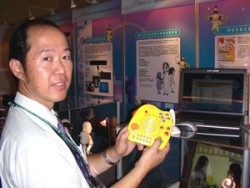Special Exhibition on Accomplishments From Cooperation Between Technical Schools and Industry in Cultural Innovation

The Ministry of Education is holding a special exhibition on the results of cooperation between technical schools and industry in cultural innovation between September 6 and October 14 this year at the National Taiwan Democracy Memorial Hall. The exhibition aims to exhibit results of outstanding cooperative R&D projects between technical schools and private industry in the field of cultural innovation in an effort to demonstrate technical schools' characteristics placing equal emphasis on both theory and practice. Everyone is welcome to visit the exhibition.
Culture is not only history, but also a manifestation of the originality of a people. Consequently, it needs to be passed down from generation to generation and cultivated. The exhibition focuses on the results of cooperation between technical schools and industry in cultural innovation, highlighting the significance and results of cultural preservation and innovation brought about by cooperation between academia and industry. In the meantime, the results of cultural innovations from various schools have been announced to enable the industry to understand developments in cultural innovation, in a bid to facilitate cooperation between industry and academia and diversify development of the industry of cultural innovation. A total of seven schools are exhibiting the results of their research and development as summarized below:
The Design Research Center of National Yunlin University of Science and Technology is presenting its innovative furniture. Its exhibitions add value to and commercialize objects of culturally inovative design, displaying six pieces including butterfly-shaped furniture and pottery that express Taiwan's identity, furniture made of bamboo in modern shapes, and Koji ceramic plates made with digitally glazed figures.
The Product Development Center of Kun Shan University titled its exhibition Living Aesthetics – Recreating Tradition. Unlike the traditional exhibits that display a single creation or technique, living technology is used to create different imaginary spaces and combinations. In addition to incorporating different designs and techniques, each piece exhibited is blended with a daily living space in a modular form based on humanistic design concepts.
The Technology Research Center of Cultural Innovation and Digital Content of Shu-Te University titled its exhibition Originality Living, Aesthetics Recreated. The exhibitions include culturally innovative products of the following categories – living, style, space and vision. The R&D effort placed an emphasis on raising products' competitiveness and added value.
The Digital Content & Multimedia Technologies Research Center of Lunghwa University of Science and Technology is demonstrating personalized puppets, laser engraving and wireless digital learning devices: (1) Personalized puppets are created through scanning the faces of real persons in 3D, incorporating digitized virtual characters' designs and transforming digital data into final products. (2) Laser engraving is made possible by concentrating laser energy on crystal until an explosive point is created. The technique is a good medium for showing three-dimensional facial expressions. Faithfully displaying scanned three dimensional facial expressions is a perfect union of science and art. (3) Wireless digital learning devices take advantage of wireless media. Once parents store music, stories or audio teaching materials in their PCs at home, they can wirelessly transmit them to childrens' handheld devices to be replayed.
The Research Center for Cultural Design and Product Innovation of Chaoyang University of Technology is announcing a technique to dye ornaments made of aluminum alloy. Because of its excellent material properties, aluminum alloy has been used to make various kinds of products ranging from sporting goods, electrical appliances, articles for daily use, construction materials, hardware and IT products. The technique involves multi-layer dyeing of aluminum alloy objects using anodization, demonstrating the modernity and variety of aluminum alloy objects.
The Research Center for Cultural Innovation Through Digital Imaging and Sound Applications at the Tainan University of Technology in recent years has endeavored to make music albums and design multimedia images and sounds through cooperation with private industry. This year, the Center won recognition and many awards at the Golden Melody Awards. At the Exhibition, the Center is exhibiting its music-related R&D results that include Cynthia's Magical Fingers.
The Center for Rehabilitation of Cultural Sites and Development at the China University of Technology is announcing a technique to digitize historic cultural structures in 3D and a technique to restore wooden modules without leaving any traces of repair: (1) The technique to restore wooden modules primarily uses high-strength reinforcements and epoxy resin. The high-strength reinforcements are inserted into the prefabricated molds of the wooden modules to be restored without showing traces of repair in an effort to reinforce the wooden modules' overall strength and durability. The restoration is made without showing traces of repair in order not to impact the modules' appearance. (2) The technique to digitize historic cultural structures in 3D uses a RIEGL LMS-Z420i 3D laser scanner and a high-definition monocular digital camera. The combination can measure a maximum range of 1000m with a maximum precision of 5mm. This is a 3D laser scanner that has the longest measuring range and highest precision in Taiwan. It is suitable for measuring and reproducing historic structures based on the need for high precision.